Generative AI is changing how businesses and professionals work across many fields. In 2025, these smart systems are set to reshape workflows, boost creativity, and speed up decision-making in ways we are only beginning to understand. This post explains the top 10 generative AI applications, how they work in real-world settings, and why they matter for agencies, companies, and tech professionals.
Below, we break down each application by industry, explain its core benefits, and offer real-life examples. We also include tables and links to trusted sources like McKinsey’s report on economic potential and Gartner’s insights on AI use cases to give you a well-rounded view of how these tools are being used today.
Introduction
Generative AI is becoming an everyday tool in business environments. By generating content, code, designs, and even research insights, these systems offer new ways to solve problems and streamline operations. As agencies, companies, and tech professionals seek more efficient solutions, understanding these applications can help you decide where to invest time and resources. In this post, we explore ten generative AI applications that are transforming industries this year. Whether you are involved in tech development, marketing, healthcare, or manufacturing, there’s something here for you.
1. AI-Powered Writing and Content Generation
1.1 Enhancing Enterprise Communication
Tools like Grammarly and ChatGPT are changing how businesses write and edit content. They analyze context and tone to suggest improvements that save time and reduce errors. For instance, marketing teams use these tools to generate SEO-friendly blog posts and reports. In legal settings, drafting contracts and policy documents has become faster and more consistent. Companies are noticing a drop in editing time by up to 40% thanks to these applications.
Hyperlinked resources such as eWeek’s overview of AI apps and tools offer further insights into how these systems are integrated into corporate communication. With these tools, written communication is not only faster but also tailored to different audiences, ensuring clear and effective messaging across global teams.

1.2 Multilingual Content Localization
Modern language models support real-time translation and cultural adjustments for content. Organizations now create region-specific marketing materials in over 100 languages. This means global brands can maintain a consistent message while adapting content to local nuances. For example, major retailers have seen a 30% reduction in localization costs, making it easier to enter new markets with tailored messaging.
Agencies can explore additional techniques for localizing content by checking out insights from Evolute IQ, which explains how these tools improve marketing efforts on a global scale.
2. Assistive Coding and Software Development
2.1 Accelerating Development Cycles
Programming assistants like GitHub Copilot and Amazon CodeWhisperer provide context-aware code suggestions and help automate repetitive coding tasks. These tools have led to a reduction in coding errors by 25% and cut development timelines by around 35%. Startups in the fintech sector, for example, have used these assistants to prototype blockchain applications quickly.
For more technical details on these tools, check out Gartner’s analysis of AI use cases, which covers how AI is making software development more agile and efficient.
2.2 Modernizing Legacy Systems
Legacy system updates can be complex and time-consuming. IBM Watsonx is one example of a tool that refactors older code, converting systems written in languages like COBOL and FORTRAN to modern languages such as Python. This transition is critical for banks and government organizations looking to upgrade their infrastructure without risking operational continuity.
Detailed case studies on such modernization projects can be found in articles like this Walturn insight, which explains how legacy systems are reimagined with AI tools.
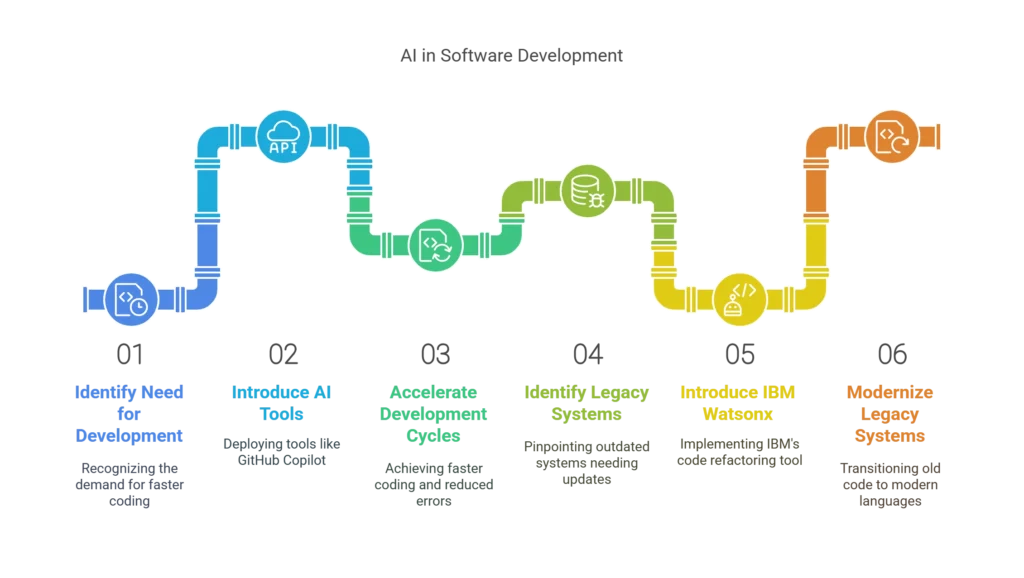
3. Healthcare Diagnostics and Patient Care
3.1 Symptom Analysis and Triage
Healthcare is experiencing significant benefits from generative AI. At institutions like Mayo Clinic, AI chatbots have been developed to conduct patient interviews, comparing symptoms against large clinical databases. These systems help triage patients by suggesting preliminary diagnoses, leading to a reduction in emergency room overload by 18% while maintaining high accuracy.
To read more about AI in healthcare, you might visit Indeemo’s blog on iterative prompting, which explains how careful prompt design can enhance diagnostic accuracy.
3.2 Accelerating Drug Discovery
Generative models are also speeding up the drug discovery process. For instance, AlphaFold 3 can predict protein structures up to 60 times faster than traditional methods. Pharmaceutical companies, such as Pfizer, have used this technology to shorten preclinical trial phases significantly. Recently, AI has identified new cancer drug candidates that are now progressing in clinical trials.
Links to further reading include this detailed breakdown by LinkedIn, which provides additional context on the research advancements in this area.
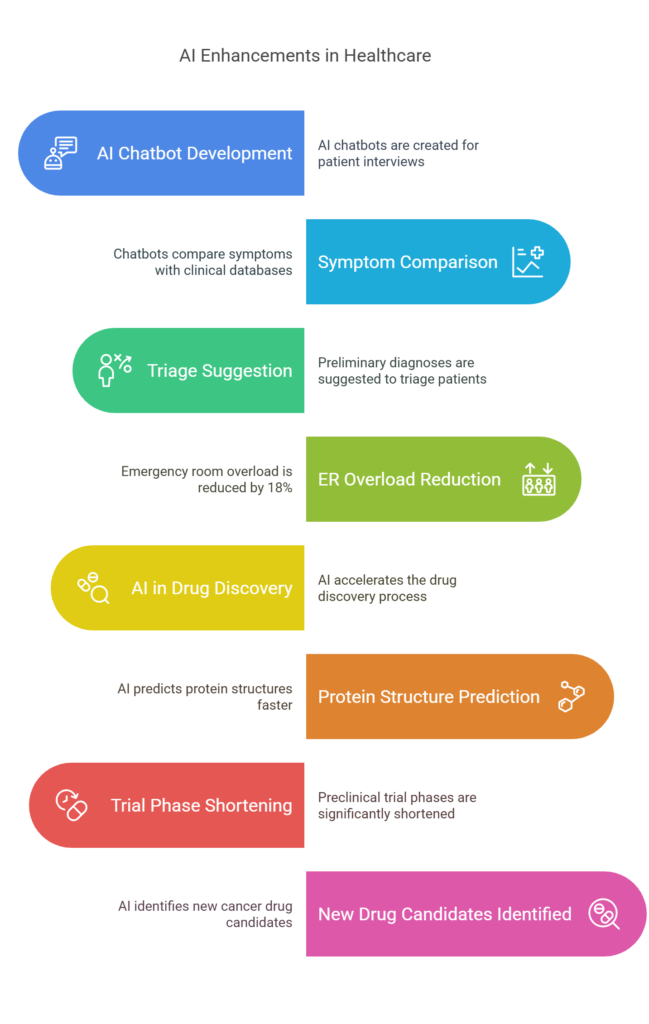
4. Automotive Design and Prototyping
4.1 Generative Design Optimization
Automotive companies are using AI to redesign and optimize vehicle parts. For example, Toyota Research Institute’s collaboration with Stability AI has led to the generation of thousands of design sketches in minutes. This has allowed the company to reduce the design phase from a year to just a few months while achieving improved aerodynamic performance.
4.2 Autonomous Vehicle Training
Self-driving car developers are employing synthetic data generators, such as Carla Simulator, to create realistic driving scenarios. Waymo’s vehicles, for example, have completed up to 80% of their training in AI-generated environments. This innovation has significantly reduced real-world testing expenses and accelerated the training process for autonomous systems.
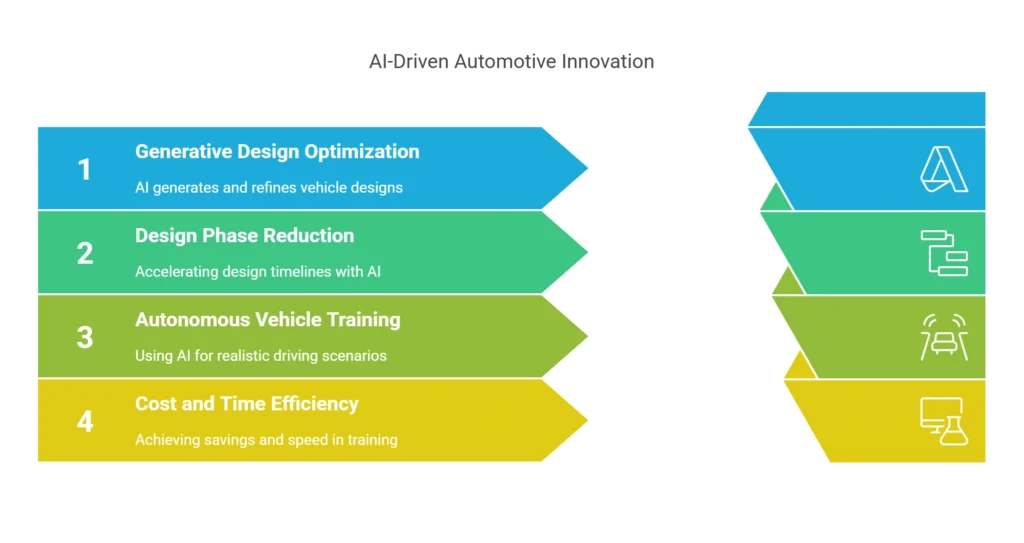
These advances not only improve safety but also cut costs, making it easier for companies to bring new automotive technologies to market.
5. Banking and Financial Services Automation
5.1 Fraud Detection Systems
Banks are increasingly using AI to monitor and detect fraudulent transactions. By processing billions of data points, systems like Claude AI can spot unusual patterns in real time. Ally Bank has used these systems to block hundreds of millions in fraudulent transfers while lowering false-positive alerts. This approach helps maintain financial security and improves overall operational efficiency.
5.2 Personalized Wealth Management
Generative AI is also used to create tailored investment strategies. At JPMorgan Chase, AI tools analyze client data and market trends to generate personalized portfolio recommendations. Similarly, tools like Google Vertex AI forecast product demand by analyzing a mix of social media, weather, and economic data. These methods have helped retailers like Walmart reduce stock discrepancies by significant margins.
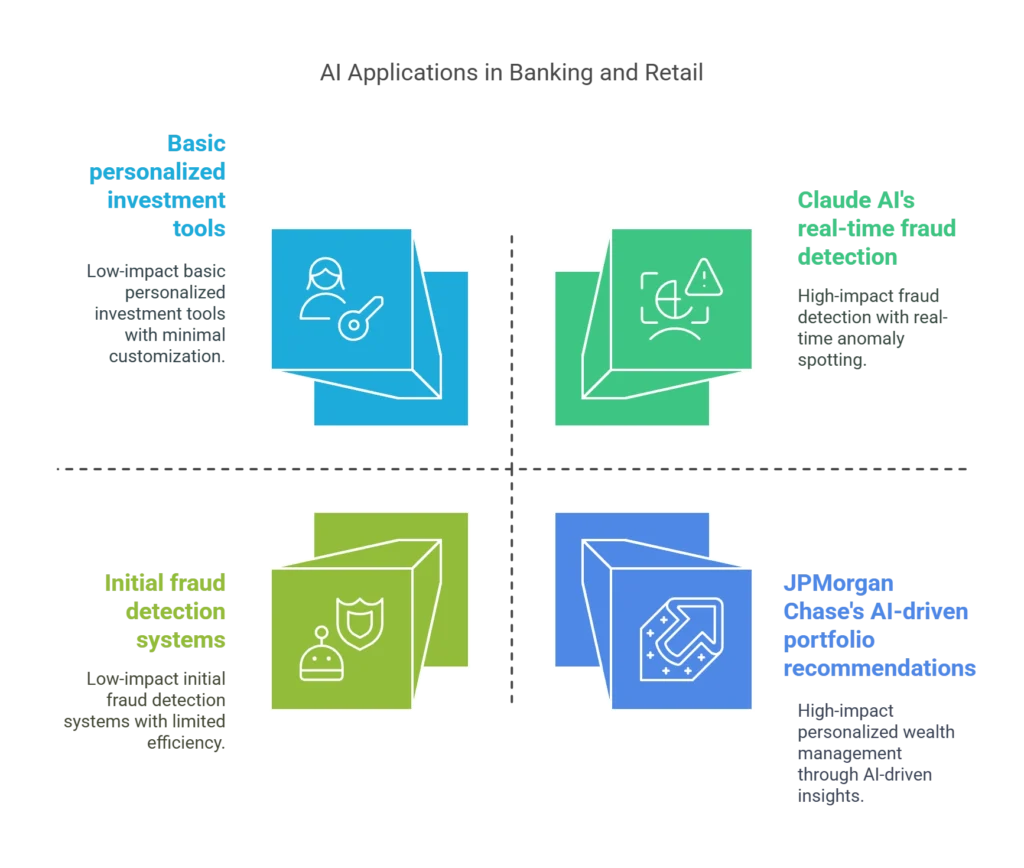
For more on the impact of AI in banking, check out insights available on McKinsey’s website.
6. Retail and Supply Chain Optimization
6.1 Demand Forecasting
Retailers are turning to AI to predict consumer demand with impressive accuracy. For instance, using platforms like Google Vertex AI, companies can combine data from various sources to forecast product demand with up to 89% accuracy. This improvement helps reduce issues such as overstock and understock situations.
6.2 Virtual Try-On Experiences
Virtual try-on applications powered by AI allow customers to see how products will look on them before making a purchase. For example, AI-driven avatars have been used by fashion retailers to present apparel in a variety of body types and skin tones. This has resulted in higher conversion rates and fewer returns, improving both customer satisfaction and sales metrics.
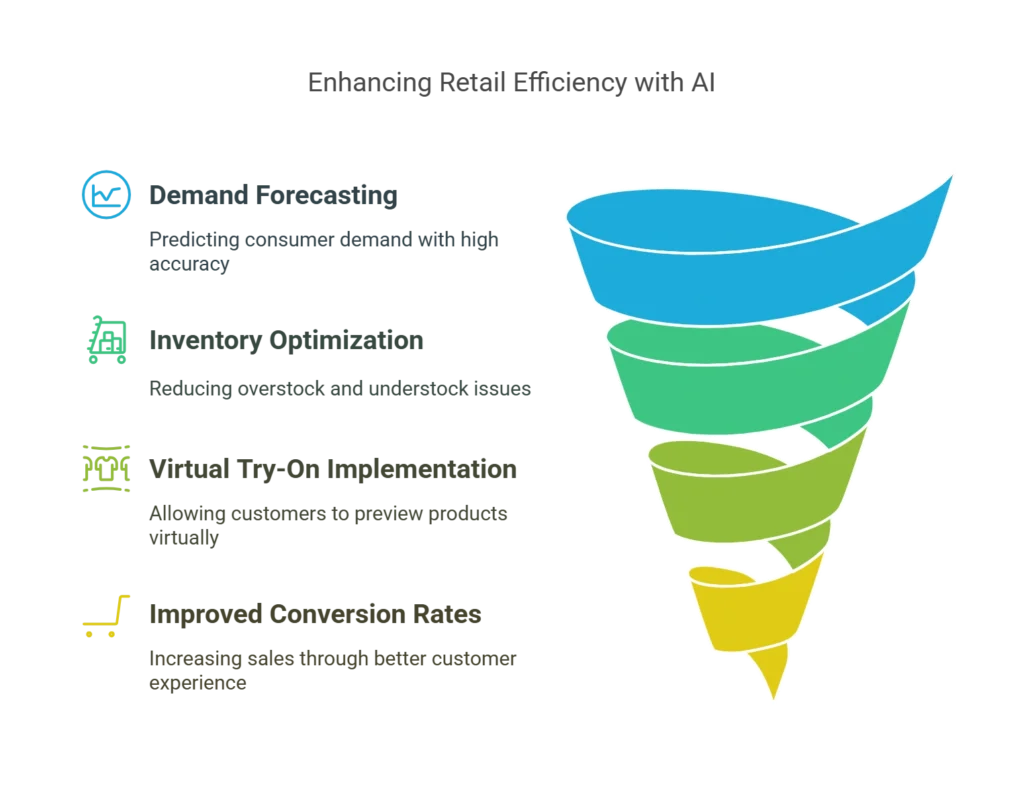
A detailed look at these technologies is available in Evolute IQ’s overview.
7. Manufacturing and Industrial Engineering
7.1 Predictive Maintenance
In the manufacturing sector, generative AI supports predictive maintenance by analyzing sensor data from thousands of machines. Systems like Siemens Industrial Copilot can forecast equipment failures days in advance, allowing companies to schedule repairs proactively. This has led to reductions in unplanned downtime and lowered maintenance costs, ensuring smoother production processes.
7.2 Sustainable Material Development
Generative AI is also helping companies develop materials with improved performance and lower environmental impact. At BASF, AI tools have been used to design new polymers that achieve a 50% reduction in carbon footprint compared to traditional materials. Several of these materials have moved into commercial production, aiding the transition to more sustainable manufacturing practices.

An accessible resource on AI’s role in industrial engineering is Gartner’s article on AI use cases.
8. Media and Entertainment Content Creation
8.1 Personalized Streaming Experiences
Content creators are using AI to tailor streaming experiences to individual viewer preferences. For example, Netflix employs systems like Dynamic Story Engine to offer alternate plot branches based on audience reactions. Early trials have resulted in longer viewing sessions and improved subscriber retention, suggesting that personalized content can keep viewers engaged for longer periods.
8.2 AI-Generated Music and Art
In the creative realm, tools like OpenAI Jukebox are collaborating with musicians to generate royalty-free tracks that fit specific moods and genres. These applications allow artists to experiment with new sounds and create music that aligns with diverse audience tastes. This innovation not only supports creative expression but also opens up new revenue streams, as seen in recent licensing successes.
For a closer look at how AI is reshaping creative workflows, you may find Indeemo’s discussion on iterative prompting useful.

9. Energy Sector Innovation
9.1 Smart Grid Optimization
In the energy sector, AI tools are being used to balance supply and demand on power grids. Smart grid optimization applications analyze consumption patterns and weather data to predict energy needs with high accuracy. This helps energy providers adjust power distribution in real time, leading to more efficient operations and a reduction in energy waste.
9.2 Nuclear Fusion Modeling
Another promising application in energy is nuclear fusion modeling. Generative AI is helping researchers simulate plasma containment and predict fusion reactions more reliably than traditional methods. Although still in its early stages, this technology may one day support cleaner energy solutions and reduce dependency on fossil fuels.
A comprehensive view of AI’s potential in energy innovation is available through resources like McKinsey’s economic potential study.
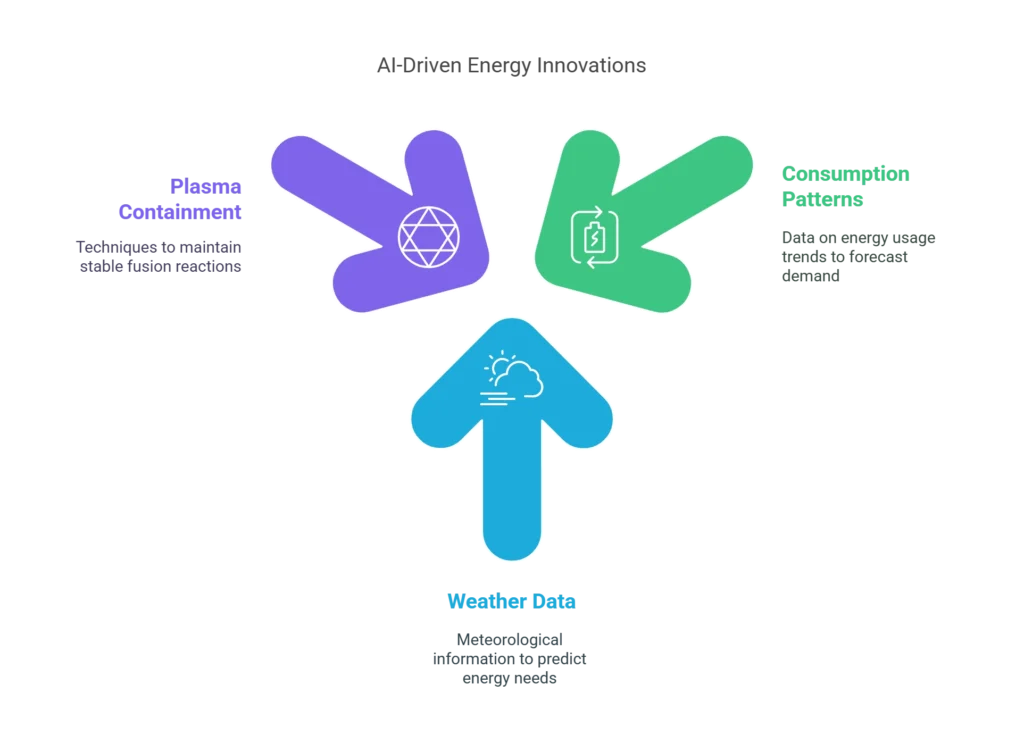
10. Academic Research Acceleration
10.1 Literature Review Automation
Generative AI is changing how researchers review and summarize academic literature. Tools that automate the literature review process are able to summarize thousands of research papers in a fraction of the time it would take a human. This automation helps academics stay current with the latest studies and accelerates the pace of innovation in research-intensive fields.
10.2 Cross-Disciplinary Insight Generation
AI-driven systems are also being used to connect insights across different scientific fields. By analyzing data from biology, physics, and materials science, these tools suggest new research directions that might not be obvious otherwise. Such cross-disciplinary approaches are fostering a more connected research landscape, making it easier for experts to collaborate and share breakthroughs.
For more perspectives on academic acceleration using AI, consider reviewing the insights shared in this LinkedIn article.
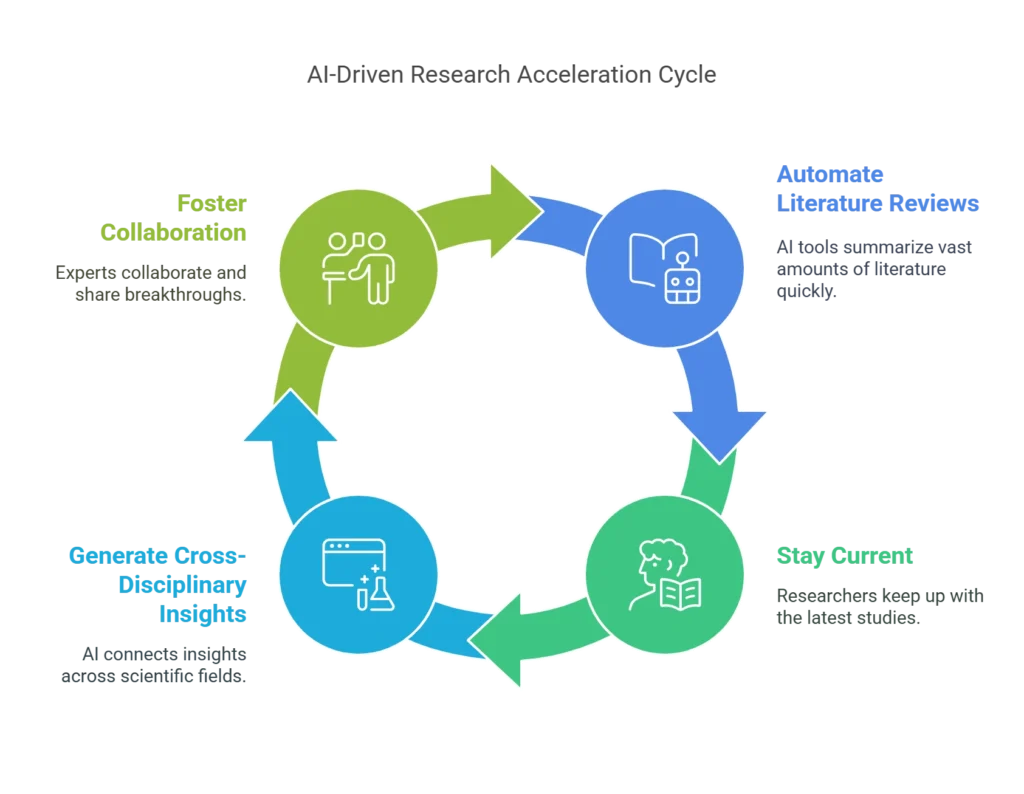
Summary Table: Generative AI Applications by Industry
| Application Area | Industry/Field | Key Benefit |
|---|---|---|
| AI-Powered Writing and Content Generation | Corporate Communication | Faster drafting and improved clarity |
| Multilingual Content Localization | Global Marketing | Cost reduction and tailored messaging |
| Assistive Coding and Software Development | Tech/Software | Reduced coding errors and quicker development |
| Legacy System Modernization | Financial/ Government | Smooth updates and continued operations |
| Healthcare Diagnostics and Patient Care | Healthcare | Efficient triaging and faster drug discovery |
| Automotive Design and Prototyping | Automotive | Faster design cycles and improved training |
| Banking and Financial Services Automation | Finance | Enhanced fraud detection and personalized advice |
| Retail and Supply Chain Optimization | Retail | Better demand forecasting and customer experience |
| Manufacturing and Industrial Engineering | Manufacturing | Predictive maintenance and eco-friendly materials |
| Media and Entertainment Content Creation | Media/Entertainment | Personalized content and new creative formats |
| Energy Sector Innovation | Energy | Optimized power distribution and fusion modeling |
| Academic Research Acceleration | Academia | Streamlined research and cross-field insights |
Table: A quick overview of how each generative AI application fits within various industries and the benefits it brings.
Practical Considerations for Implementation
When integrating these AI applications into your business processes, it is essential to consider a few practical aspects:
- Integration with Existing Systems:
Whether you’re modernizing legacy code or updating your marketing approach, ensuring that new AI tools integrate seamlessly with current systems is key. This might mean training staff, updating infrastructure, or setting up hybrid systems where human oversight complements automated processes. - Ethical and Responsible AI Usage:
As with any new technology, it is important to adopt ethical practices when using generative AI. Tools for bias audits, such as IBM’s AI Fairness 360 toolkit, can help identify and address potential issues in training data. The EU’s AI Act, for example, requires detailed model cards that explain system limitations, ensuring transparency and accountability in AI applications. - Cost and Resource Management:
Investments in AI tools can be significant, but many organizations are finding that the benefits—such as reduced costs in localization, maintenance, or testing—outweigh initial expenses. Evaluating the return on investment (ROI) through pilot programs and phased rollouts can be a smart strategy. - Staff Training and Upskilling:
AI tools work best when paired with knowledgeable users. Providing training sessions and upskilling opportunities for your workforce can help maximize the benefits of these technologies while ensuring that your team feels confident in their daily tasks.
For further reading on best practices, Walturn’s insights on business AI applications provide useful strategies for integrating these tools into your operations.
Conclusion and Next Steps
The applications described above show how generative AI is set to reshape industries in 2025. From making written communication smoother to helping companies design smarter vehicles, these tools offer tangible benefits that go beyond mere cost savings. For agencies, companies, and tech professionals, staying informed and testing these technologies can lead to smarter business decisions and a more agile work environment.
If you are considering an investment in AI, start by identifying which processes in your organization could benefit most from automation or enhanced data analysis. Explore case studies from trusted sources like McKinsey and Gartner to see how industry leaders are approaching the change.
As you explore these opportunities, remember that the key to success lies in continuous learning and adaptation. Engage with online communities, attend webinars, and read up on the latest research to ensure that your organization remains competitive in a rapidly changing market.
Call to Action
Are you prepared to see how generative AI can change your business? Take the first step by reviewing your current digital processes and exploring one of the tools mentioned in this post that could help. Whether it’s improving your content creation, speeding up your development cycle, or increasing your operational efficiency, it’s time to act now. To go deeper into practical AI solutions, check out the best AI productivity tools of 2025. Don’t forget to share your thoughts in the comments or contact our team to discuss how to effectively implement these strategies.
This blog post presents the top 10 generative AI applications across different industries. These tools are changing the ways of doing business and the more of them are being implemented, the better. To gain a more in-depth understanding of each application, refer to the linked resources and other trusted insights mentioned in the post.
By adopting these new tools, companies can improve not only their performance but also develop new approaches to creativity and innovation. Transition to a smarter and more effective workplace is possible only if we embrace innovation, experiment, and adopt the best practices outlined by professionals.
In the next few years, we can expect very powerful AI systems that will combine text, images, and perhaps even sensor information. No matter the industry – finance, healthcare, or media – these developing tools will provide new ways to improve your work and engage with your customers. More updates on the generative AI advancements and its impact will be available soon.
Remember to check out resources like Indeemo’s guide on iterative prompting and the LinkedIn piece on advanced research prompts for additional strategies and insights that can help you make the most of these innovations.
This blog post is intended to assist you in taking advantage of the changes that are coming with generative AI in 2025. With the help of practical examples, useful tables, and hyperlinks to credible sources, you are now equipped with the information that you need to go and apply these applications in your organization. Whether you are upgrading your technology architecture or discovering new business models, generative AI is a significant tool for transformation and growth.
Continue your journey by liking this post and sharing it with your friends, families, and coworkers, and continuing your research on AI-powered solutions and how you can incorporate them into your daily work. The future is here, and it’s time to get the most out of these advanced applications.










































Comments 2